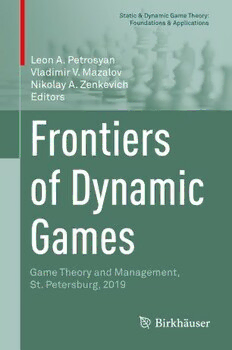
Frontiers of Dynamic Games: Game Theory and Management, St. Petersburg, 2019 PDF
Preview Frontiers of Dynamic Games: Game Theory and Management, St. Petersburg, 2019
Static & Dynamic Game Theory: Foundations & Applications Leon A. Petrosyan Vladimir V. Mazalov Nikolay A. Zenkevich Editors Frontiers of Dynamic Games Game Theory and Management, St. Petersburg, 2019 Static & Dynamic Game Theory: Foundations & Applications SereisEditor TamerBas¸ar,UniversityofIllinois,Urbana-Champaign,IL,USA EditorialBoardMembers DaronAcemoglu,MassachusettsInstituteofTechnology,Cambridge,MA,USA PierreBernhard,INRIA,Sophia-Antipolis,France MaurizioFalcone ,UniversitàdegliStudidiRoma“LaSapienza,”Italy AlexanderKurzhanski,UniversityofCalifornia,Berkeley,CA,USA Ariel Rubinstein, Tel Aviv University, Ramat Aviv, Israel; New York University, NY,USA WilliamH.Sandholm,UniversityofWisconsin,Madison,WI,USA YoavShoham,StanfordUniversity,Stanford,CA,USA GeorgesZaccour,GERAD,HECMontréal,Canada Moreinformationaboutthisseriesathttp://www.springer.com/series/10200 Leon A. Petrosyan (cid:129) Vladimir V. Mazalov (cid:129) Nikolay A. Zenkevich Editors Frontiers of Dynamic Games Game Theory and Management, St. Petersburg, 2019 Editors LeonA.Petrosyan VladimirV.Mazalov St.PetersburgStateUniversity InstituteofAppliedMathematicalResearch St.Petersburg,Russia RussianAcademyofSciences Petrozavodsk,Russia NikolayA.Zenkevich GraduateSchoolofManagement St.PetersburgStateUniversity St.Petersburg,Russia ISSN2363-8516 ISSN2363-8524 (electronic) Static&DynamicGameTheory:Foundations&Applications ISBN978-3-030-51940-7 ISBN978-3-030-51941-4 (eBook) https://doi.org/10.1007/978-3-030-51941-4 MathematicsSubjectClassification:90B,91A,91B ©TheEditor(s)(ifapplicable)andTheAuthor(s),underexclusivelicencetoSpringerNatureSwitzerland AG2020 Thisworkissubjecttocopyright.AllrightsaresolelyandexclusivelylicensedbythePublisher,whether thewhole orpart ofthematerial isconcerned, specifically therights oftranslation, reprinting, reuse ofillustrations, recitation, broadcasting, reproductiononmicrofilmsorinanyotherphysicalway,and transmissionorinformationstorageandretrieval,electronicadaptation,computersoftware,orbysimilar ordissimilarmethodologynowknownorhereafterdeveloped. Theuseofgeneraldescriptivenames,registerednames,trademarks,servicemarks,etc.inthispublication doesnotimply,evenintheabsenceofaspecificstatement,thatsuchnamesareexemptfromtherelevant protectivelawsandregulationsandthereforefreeforgeneraluse. Thepublisher,theauthors,andtheeditorsaresafetoassumethattheadviceandinformationinthisbook arebelievedtobetrueandaccurateatthedateofpublication.Neitherthepublishernortheauthorsor theeditorsgiveawarranty,expressedorimplied,withrespecttothematerialcontainedhereinorforany errorsoromissionsthatmayhavebeenmade.Thepublisherremainsneutralwithregardtojurisdictional claimsinpublishedmapsandinstitutionalaffiliations. Thisbook is published underthe imprint Birkhäuser, www.birkhauser-science.com, bythe registered companySpringerNatureSwitzerlandAG. Theregisteredcompanyaddressis:Gewerbestrasse11,6330Cham,Switzerland Preface Thecontentofthisvolumeismainlybasedonselectedtalksthatweregivenatthe “InternationalMeetingonGameTheory(ISDG12-GTM2019),”asjointmeetingof “12thInternationalISDGWorkshop”and“13thInternationalConferenceonGame TheoryandManagement,”heldinSt.Petersburg,RussiaonJuly03–05,2019.The meetingwasorganizedbySt.PetersburgStateUniversityandInternationalSociety ofDynamicGames(ISDG). Every year starting from 2007, an internationalconference“Game Theory and Management” (GTM) has taken place at the Saint Petersburg State University. AmongtheplenaryspeakersofthisconferenceseriesweretheNobelPrizewinners RobertAumann,JohnNash, ReinhardSelten, RogerMyerson,Finn Kidland,Eric Maskin, and many other famous game theorists. The underlying theme of the conferencesis the promotionofadvancedmethodsformodelingthe behaviorthat eachagent(alsocalledplayer)hastoadoptinordertomaximizehisorherreward once the reward does not only depend on the individualchoices of a player (or a group of players), but also on the decisions of all agents that are involved in the conflict (game). In particular, the emphasis of the ISDG12-GTM2019conference wasonthefollowingtopics: (cid:129) Cooperativegamesandapplications (cid:129) Dynamicgamesandapplications (cid:129) Pursuit-evasiongames (cid:129) Dynamicnetworks (cid:129) Stochasticgamesandapplications (cid:129) Marketmodels (cid:129) Networkinggames (cid:129) Auctions (cid:129) Game theory applications in fields such as strategic management, industrial organization, marketing, public management, financial management, human resources,energyandresourcemanagement,andothers. v vi Preface In this volume, two sorts of contributions prevail: chapters that are mainly concernedwith the applicationof game-theoreticmethodsand chapterswherethe theoreticalbackgroundisdeveloped. InthechapterofPetrAgeevandSvetlanaTarashnina,athree-playerhierarchical game with perfect information modeling the competition on telecommunication marketisconsidered.TheNashequilibriumisfoundandtheresultsareillustrated onanexample. In the chapter of Sadettin Haluk Citci and Kubra Uge, dynamic Bertrand competitioninmixedoligopolywhereaprivatefirmcompeteswithasocialwelfare maximizingpublicfirmisconsidered.Thecorrespondinggame-theoreticmodelis constructed and it is proved that under some conditions the game possesses the uniqueBayesequilibriumindominantstrategies. In the chapter of Denis Fedyanin, the version of Tullock rent-seeking game is considered.Theresultsprovideinsightsintotheimpactofreflexiveanalysisonthe propertiesofinformationcontrol.Inthemostsimplecase,theNashequilibriumis foundanditspropertiesarediscussed. In the chapter of Ekaterina Gromova and Anastasiya Malakhova, a special differential 3-person cooperative game on network is considered. For finding solutions in such class of games, the characteristic function must be calculated. There are differentapproachesfor the definition of this function. The authors use classicalNeumann–Morgensternapproachandfoundthevaluesofthisfunctionin explicitform. In the chapterofIgorKonnov,the problemoffindingthe optimalperformance of a composite system taking in account the possible external interference and correspondingprotecting measures. In general, the problem can be formulated as a parametric zero-sum game. The author proposes an inexact penalty method for thesolutionwhichcanbeappliedalsotomoregeneralcases. In the chapter of Alexei Korolev, the network game-theoretic model with production and knowledge externalities and stochastic parameters is considered. Theexplicitexpressionsforthedynamicsofasingleagentanddyadagentsinthe formofBrownianrandomprocessesarederivedandthequalitativeanalysisofthe solutionsisprovided. In the chapter of David A. Kosian and Leon A. Petrosyan, the new type of characteristic functionfor the cooperativegameswith hypergraphcommunication structureis proposed.Thevalueofthe characteristicfunctionforeach coalitionis computedassumofthecooperativepayoffsofplayersfromthiscoalitionunderan additionalconditionthatplayersoutsidethecoalitionarecuttinglinkswithcoalition members.Isitprovedthatthecorrespondinggameisconvex. In the chapter of Nikolay A. Krasovskii and Alexander M. Tarasyev, the algorithm is developed for finding the value function of the zero-sum setting for differential dynamic bimatrix games on an infinite time interval. The results are illustrated on nontrivial and interesting example of 2 × 3 bimatrix game. The constructionofthevaluefunctionsofbothassociatedzero-sumgamesisprovided andafeedbackstrategyofthefirstplayerisfound. Preface vii In the chapter of Suriya Kumacheva, Elena Gubar, Ekaterina Zhitkova, and Galina Tomilina, the effect of information spreading about future tax audits is consideredusinganevolutionarygameapproach.Thescenarioanalysishasshown that the propagationof information about the possible audit may increase the tax collection. In the chapterofDenisKuzyutin,IvanLipko,YaroslavnaPankratova,and Igor Tantlevskij, the problem of time consistency of cooperative solutions in dynamic multicriterialgamesisconsidered.ThevariationofaknownIDPtechniquewhich guaranteesthenonegativityofstagepaymentsnecessaryfortherealizationoftime- consistentsolutionsisproposed.Resultsareillustratedoninterestingexamples. Intheirchapter,MarioAlbertoGarciaMezaandCesarGurrolaRiosconsidered conditionsunderwhichthecooperationbetweencompaniesmaygivebetterresults thancompetition.Whilesubstitutegoodshardlyfindsolutionforcooperation,inthe articletheexamplesaregivenonhowthecomplementarilycanachievesuchresults. Theexistingtime-consistencyproblemincooperationisnotconsidered. In the chapter of Ekaterina Orlova, the one-shot cooperative game model of Eurasian gas network is considered and different solution concepts such as the Shapley value, core, and nucleolus are compared. Among other topics, the effect of liberalizationis studied.Manyinterestingexamplesbased on realdata analysis arepresented. InthechapterofDmitryRokhlinandGennadyA.Ougolnitsky,thecontinuous- time dynamicgamein the case of one leader and one followeris considered.The conditions for the existence of Stackelberg solution are derived and the solution is found in explicit form in a game-theoretic model of a nonrenewable resource extractionproblem. In the chapterof OvanesPetrosian, Maria Nastych, andYin Li, the differential game model is applied to analyze the world oil market. The looking forward approach is proposed to take into account dynamically updating information. To model the situation on different time intervals, non-cooperative and cooperative approaches are used. The numerical simulations based on open access date are presented. In the chapter of Simon Rothfuß, Jannik Steinkamp, Michael Flad, and Sören Hohmann,thegame-theoreticapproachisusedtomodeltheinteractionofhumans and automated assistant systems. The goal is to design emancipated cooperative decision-makingsystemscapableofnegotiatingwithhumans.Twogameconcepts: event-based game and game model based on war of attrition are proposed for describingthenegotiationprocess. Alexander Sidorov in his chapter tries to show on developed mathematical models that in some cases the typical presumptionof the most economic theories thatfreeentryisdesirableforsocialefficiencymaynotbealwaystrue.Heconsiders the one-sector economy with horizontally differentiated good and one production factor-laborwithspecialclassesofutilityfunctions. Igor Shevchenko in his chapter considers a classical game of obstacle tag proposed first by R. Isaaks in his book. The solution of the game in the sense of saddlepointisnotknownalthoughmanypapersarepublishedonthesubject.The viii Preface authorproposesthestrategyforthepursuerwhichallowshimtochoosethegeodesic linesandevaluatestheguaranteedresultsforthisstrategy. The ISDG12-GTM2019 program committee thanks all the authors for their active cooperation and participation during the preparation of this volume. Also, theorganizersoftheconferencegratefullyacknowledgethefinancialsupportgiven bytheSaintPetersburgStateUniversity.Lastbutnotleast,wethankthereviewers fortheiroutstandingcontributionandthescienceeditor. SaintPetersburg,Russia L.A.Petrosyan Petrozavodsk,Russia V.V.Mazalov SaintPetersburg,Russia N.A.Zenkevich Contents 1 CompetitionasaHierarchicalMultistageGame ....................... 1 PetrAgeevandSvetlanaTarashnina 2 InformationExchangeinPriceSettingMixedDuopoly................ 13 SadettinHalukCitciandKubraUge 3 ReflexiveandEpistemicPropertiesoftheTullockRent-Seeking Game......................................................................... 25 DenisFedyanin 4 SolutionofDifferentialGameswithNetworkStructure inMarketing ................................................................ 37 EkaterinaGromovaandAnastasiyaMalakhova 5 PenaltyMethodforGamesofConstraints............................... 49 IgorKonnov 6 Adjustment DynamicsinNetworkGameswithStochastic Parameters .................................................................. 65 AlexeiKorolev 7 NewCharacteristicFunctionforCooperativeGameswith HypergraphCommunicationStructure.................................. 87 DavidA.KosianandLeonA.Petrosyan 8 MinimaxGeneralizedSolutionsofHamilton-JacobiEquations inDynamicBimatrixGames.............................................. 99 NikolayA.KrasovskiiandAlexanderM.Tarasyev 9 AnalysisofEconomicBehaviourinEvolutionaryModelofTax ControlUnderInformationDiffusion.................................... 121 SuriyaKumacheva,ElenaGubar,EkaterinaZhitkova,andGalina Tomilina ix
